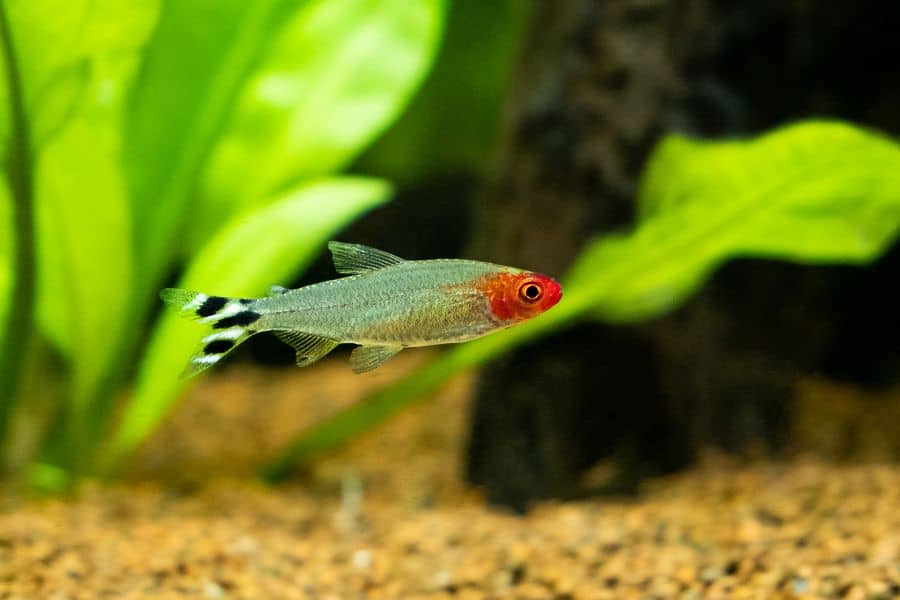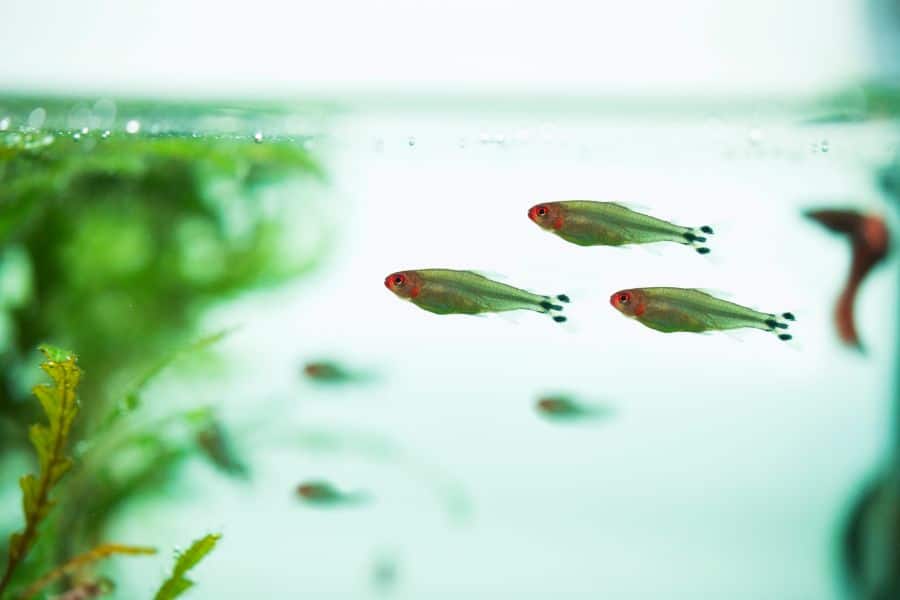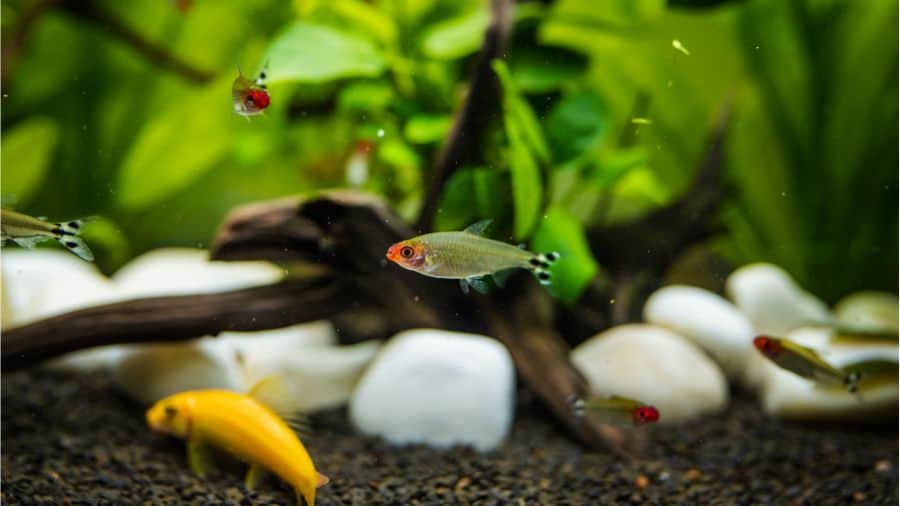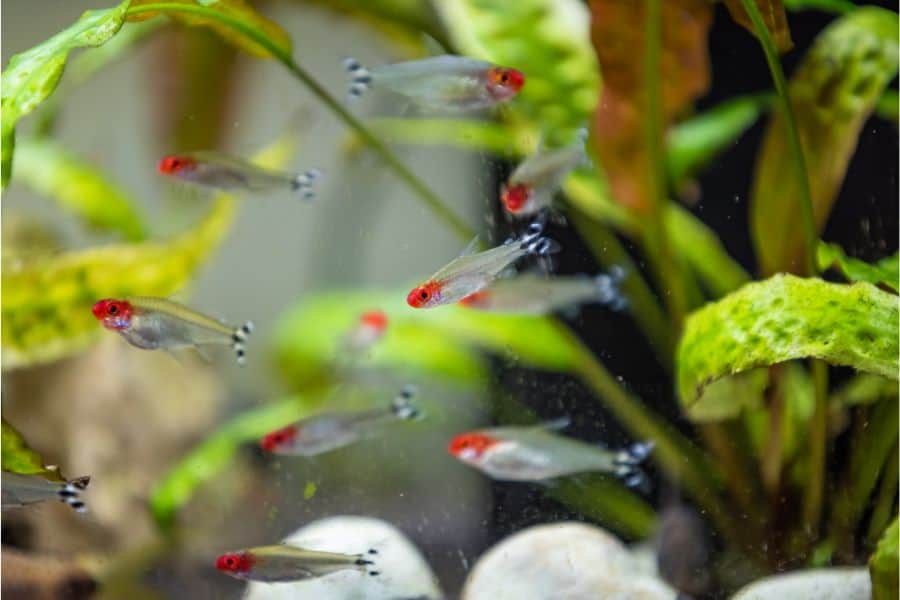Perhaps you’ve thought about adding more fish to your aquarium but didn’t want the hassle of choosing different varieties of fish to individually care for.
Rummy nose tetra may just be what you need and, in this article, we’ll be going over all there is to know about this fish, including how to care for them, and the different variants you may encounter.
The rummy nose tetra is a type of tetra (roughly 2.5 inches long) that thrives in tropical freshwater, where it can live up to 6-8 years. In order to provide the fish a comfortable living environment, you’ll need roughly a 20-gallon (or preferably more) tank, along with relatively warm and slightly acidic freshwater.
Before discussing the caring process for rummy nose tetra, let’s first take a look at what they are exactly so that everything afterwards makes sense.
What Is Rummy Nose Tetra?
Here, we’ll take a look at things such as the origins of the fish, their physical characteristics, and their behavior so that you’ll know if they’ll be a good fit for your aquarium.
Where Do Rummy Nose Tetra Come From?
Rummy nose tetra is native to the Amazon river in South America. They are typically found in slow-moving forest creeks, where there’s an abundance of leaflitter and detritus.
The habitats where these fish are found typically include few to no aquatic plants, though you’ll find many leaves carpeting the ground, while floating plants and plants growing adjacent to the creeks provide much of the shade and shelter this fish needs.
Physical Characteristics of the Rummy Nose Tetra
Rummy nose tetra is a rather small type of tetra fish, usually growing no more than 2.5 inches long. The common/brilliant runny nose tetra typically grows only up to 2 inches in length.
Though the exact appearance of the fish will depend on the variation, they mainly consist of plain silver bodies with their dorsal sides being silver-brown, white tails with broad black stripes, and red faces. Their bodies are quite slim and long, resembling a torpedo, with translucent fins.
Lifespans for Rummy Nose Tetra
Rummy nose tetras typically live about 5-6 years on average in captivity, though exceptional cases of over 8 years have been recorded. Of course, how long your particular fish will live will depend on various factors, such as the diet its receiving and the conditions of your aquarium.
Rummy nose tetras lifespans in the wild are not well documented, as similar to those in captivity, their survival depends on a plethora of factors, such as the presence of natural predators and their surrounding environment.
The lifespans of this fish don’t appear to vary from gender to gender or on variation.
What Variations Are There of The Rummy Nose Tetra?
There are overall three variations of the rummy nose tetra: the true rummy-nose tetra, the brilliant rummy-nose tetra, and the false rummy-nose tetra.
The Brilliant Rummy Nose Tetra
Of the three variants, the brilliant rummy nose tetra is the one that is typically shorter than the others, growing up to a maximum 2 inches in length.
Another unique trait of this variant is the fact that it’s the only one to have the red coloration on their head extend past their gills. They may also appear to have a slightly tapered, diamond shape.
The False Rummy Nose Tetra
All rummy nose tetras have a dark blotch on top of their caudal peduncle, but the false rummy nose tetra is the only one that lacks it on the bottom.
Another distinguishable characteristic is that the false rummy nose tetra is the only one to have the middle black streak on their tail extend up to the back half of their body. This makes the streak look closer to a short straight line then just a blotch on the tail.
Caring for Rummy Nose Tetra
Rummy nose tetras are generally a peaceful species that are easy to care for and pair well with other peaceful fish. With that in mind, there are some things to keep in mind and look out for when setting up their tank and caring for them.
The Appropriate Tank Size
Though small, rummy nose tetras are naturally found in large groups (otherwise known as schools), meaning they typically require a tank larger than you’d think. Usually, you’d need at least a 20-gallon tank in order to give these fish ample room to swim around.
There is a rule of thumb that states that each inch of fish will require one gallon of water. If this is to be followed, then 10 rummy nose tetras (each measuring roughly 2 inches in length) would require a 20-gallon tank.
Of course, you can always go for more room so that you never risk the fish feeling cramped. As such, a 30, or even 40-gallon tank, may be considered.
How Many Rummy Nose Tetras in A 30 Gallon Tank?
According to the rule of thumb previously discussed, assuming that each rummy nose tetra is 2.5 inches in length, a 30-gallon tank would be able to hold exactly 12 of these fish.
This is if you wish to follow this rule wholeheartedly and to the exact number.
If you wish to, say, give the fish a bit more excess room, you could increase the rule where each inch of fish accounts to 1.5 gallons of water. In this case, you’ll be able to fit exactly 8 rummy nose tetras in a 30-gallon tank, which would provide much more room for the fish to swim in.
Setting the Aquarium Water
As rummy nose tetra is a tropical freshwater species, the aquarium water will need to be relatively warm compared to your typical aquarium, with temperatures between 72- and 80-degrees Fahrenheit being ideal.
In most cases, you’ll need a small heater and an aquarium thermometer to maintain this temperature.
As for the pH, rummy nose tetra does best in slightly acidic environments, hence the water should have a pH of roughly between 5.5 and 7.0.
As for pretty much any aquarium fish, it’s important to keep ammonia and nitrate levels as low as possible (preferably none) in the tank in order to ensure no harm comes to the fish.
Choosing Tank Mates for The Rummy Nose Tetra
Because rummy nose tetras are relatively gentle and peaceful fish that rarely show aggression, it’s important that any tank mates for these fish should display similar personality traits. If you place aggressive fish in the tank, you may risk these fish bullying or even feeding on the rummy nose tetras.
Other traits to consider are if the tank mates are also similar sized, prefer living in communities, and are adapt to live in warmer waters, similar to rummy nose tetras.
By overall having very similar physical and behavioral traits to rummy nose tetra, these tank mates will have the least risk of potentially harming the tetras.
Here are some example species that you can consider adding to your rummy nose tetras as tank mates:
- Other tetras
- Danios
- Cory catfish
- Mollies
- Cherry barbs
- Guppies
- Different snail species
- Different shrimp species
Keep in mind that there’s always the risk of the rummy nose tetras eating small fry or shrimp, so its best if your tank mates are all adults to prevent such occurrences.
Feeding Rummy Nose Tetras
Rummy nose tetras are omnivores, meaning they consume a large variety of foods, such as small crustaceans, insects and their larvae, plant debris, fish eggs, and of course, the conventional fish food.
While their diet in the aquarium should be fairly varied, their main source of nutrition should come from high-quality tropical fish flakes, preferably those specific to rummy nose tetras. Pellets would also work, but flakes are typically recommended.
You may also supplement their diet with treats, such as live, frozen, or freeze-dried daphnia, bloodworms, and brine shrimp. Freeze-dried foods are best as this process prevents the risk of parasitic infections.
Other foods include the occasional blanched green vegetables, such as spinach, lettuce, and zucchini. Remember that these foods, along with the live prey discussed earlier, should be considered supplementary; you should always feed your tetras primarily with fish flakes/pellets.
Breeding Rummy Nose Tetra
Although caring for rummy nose tetra is relatively straightforward, mating them might require a bit more effort. Here’s what you’ll need and the steps you’ll have to follow:
Choosing the Right Mate
The issue when mating rummy nose tetra is that these fish are notoriously difficult to differentiate sex-wise.
Besides the fact that females tend to be a bit larger than males, and have a slightly rounder, heavier, and longer body, there’s not much that differentiates the two sexes.
Another sign to look out for is if some fish begins to grow a larger belly around the 8 months to 1-year mark, as this is a sign of female fish beginning to accumulate eggs.
If you don’t notice any discernable differences between the fish, you might need to call a professional.
Either way, you’ll want to confirm their sex as soon as you buy them in order to ensure you meet the preconditions to mate them.
Setting the Tank
Tank Size – After you’ve picked out a male and female, it’s time to set up a separate breeding tank of roughly 10 gallons in size. Any smaller than 10 gallons would be insufficient.
Water Temperature – The water of the breeding tank needs to be slightly warmer than the water in the aquarium, with optimal temperatures ranging between 82- and 86-degrees Fahrenheit (27.7 to 30 degrees Celsius).
Water pH – The pH should be set between 6 and 6.2, with 6.1 being optimal.
Water Filter – You should have a decent filter set up so that the water quality is where it needs to be. Aquarium-safe peat can be considered for this.
Protection for the Eggs – You’ll also want to add some spawning mops, java moss, or other items to the bottom of the tank so that the female can lay her eggs in a secure location.
You may also consider using a spawning mesh net, which will allow the eggs through but keep the adult fish out. Both methods will prevent the adults from accidentally consuming the eggs or fry.
Adding Plants – Finally, you may add some leafy plants to the tank so that the fish can have privacy when mating or depositing the eggs.
The Breeding Process
- Once the tank is set up and the fish are added to the tank, they should begin spawning within two days
- If no activity happens within two days, decrease the temperature of the water by a few degrees on the third day, and increase it back on the fourth (to encourage the spawning process)
- The male rummy nose tetra will chase and tire out the female until the latter swims under a leaf, typically one that is at the water’s surface or on top of the breeding mesh or breeding mops
- The male will bend and turn the female over, fertilizing the eggs in the process
- The eggs, typically between 5 and 8, will drop from the female into the breeding moss or past the breeding mesh
- The female will appear pale and hide among the leaves and plants once breeding has finished, indicating its time to remove the adults from the tank
Caring for The Fry
Once the eggs are laid, the fry will hatch in about 24 hours, after which they will begin swimming around once roughly six days have passed.
The fry will require specialized fish fry food at first until they become large enough to consume small amounts of regular rummy nose tetra food. You may add them to the main tank once they’re fully grown.
Read More:
Conclusion
Rummy nose tetra is a common aquarium fish due to its unique physical appearance and its schooling behavior, making your aquarium easily appear livelier.
Though sometimes not considered the easiest fish to keep as a beginner, as long as you follow the guidelines in this article, you should have no trouble turning your tank into a tropical paradise.




